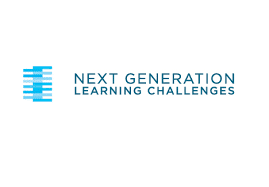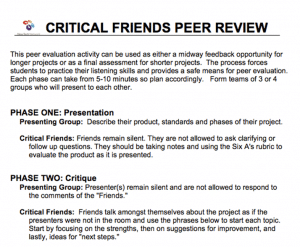Friday Focus: Cultivating Peer-to-Peer Feedback
CompetencyWorks Blog
 This post is adapted from the Next Generation Learning Challenges’ Friday Focus from February 3, 2017.
This post is adapted from the Next Generation Learning Challenges’ Friday Focus from February 3, 2017.
In this week’s Friday Focus, we discuss ways to help students and adults alike develop and strengthen their peer-to-peer feedback chops, an important and necessary skill for all learners.
Theories about Feedback
“Helpful feedback is goal-referenced; tangible and transparent; actionable; user-friendly (specific and personalized); timely; ongoing; and consistent,” writes Grant Wiggins in Seven Keys to Effective Feedback. Giving and receiving quality feedback requires that we listen carefully, observe, and reflect, and then synthesize and frame our thoughts and critiques in a way the recipient can hear and be able to use. In our NGLC grantee schools where feedback is an essential component to the learning experience, we see an emphasis on building strong relationships in which learners trust each other and know that feedback is being given in their best interest. We also see a focus on having a growth mindset, in which the person receiving the feedback understands it’s a necessary part to learning.
Sometimes, in schools, feedback can be provided by a critical friend, “someone who is encouraging and supportive, but who also provides honest and often candid feedback that may be uncomfortable or difficult to hear,” as defined by The Glossary of Education Reform.
An Evidence Base for Feedback
When trained in protocols, practiced, and emphasized, peer feedback at the student-peer level and the educator or colleague-peer level, within and outside of school settings, has been shown to have an impact on performance, community, culture, learning, and more. Explore the research below to learn more about feedback’s impact and how feedback is being implemented in the learning process:
- Peer versus expert feedback: An investigation of the quality of peer feedback among secondary school students. In this study, researchers explore the quality of peer feedback; whether students adapt their work based on feedback; and whether feedback was scientifically accurate (it was)! Despite the study’s small sample size, it’s useful when studying the research base supporting feedback’s role in learning.
- Fostering critical thinking and reflection through blog-mediated peer feedback. There are many modes and models for providing peer feedback. This study explored how digital tools, specifically blogs, affected the frequency, depth, and quality of critical feedback on students’ writing.
The Workshop School: Clear & Concise Feedback During Presentations
At the Workshop School, feedback is an important part of learning. Students practice and are expected to be able to give feedback in a way that is appropriate and useful and, on the flip side, students learn how to receive feedback with openness and apply what they hear to their approach or work. One place you really see this in action is during students’ Gateway Project presentations. In 10th grade, Workshop students present a portfolio of work to demonstrate they are ready to transition to the Upper House Program, which involves more time spent on off-site internships, access to college classes, and the opportunity to design their own projects. (As you can imagine, students really want to get in!) These presentations of their work are given to a panel of reviewers, and afterward their peers have a chance to provide verbal and written feedback on the quality of the work and presentation itself. Listen in as student Gio offers feedback to his classmate.
Feedback is personal. When you create something, share something, or articulate your ideas, you are opening yourself up—you are vulnerable. It’s important when we talk about using feedback in the learning process that we acknowledge this with each other and our students. It’s also why using protocols and communication techniques can be an effective way to ensure that feedback is meaningful and thoughtful. (Nobody likes to hear, “I think you could have done better” without some context to back it up!) At New Tech Network, where schools are built around a project-based learning model, feedback is a core component to the experience, and they have some great tools to do it well. New Tech Network’s Critical Friends Peer Review provides steps and prompts on how students can approach sharing projects, what listeners should be paying attention to, and how to give feedback. Rubrics are also an important component to ensure projects are being evaluated on certain criteria. Here’s the 6 A’s Project Idea Rubric for review.

Weekly Feedback Cycles at Gilroy Prep
Gilroy Prep, a charter school that serves kindergarteners through 5th grade in Gilroy, California, has an instructional model based on research and application by well-known and effective blended schools like Rocketship and Kipp Heartwood Academy. And one fundamental aspect of the staff’s learning experience is regular coaching. Weekly feedback cycles include video and written feedback for teachers, as well as tactical next steps (e.g., try to not write with your back facing kids for more than five seconds at a time). This focus creates opportunities for teachers to engage in the deliberate practice necessary to build effective classroom management skills. Case in point: last year when we were visiting the school, we went into a first-year kindergarten teacher’s classroom and were amazed by her seamless transition times and her ability to engage every child at all times. The feedback cycles encourage rapid prototyping and regular coaching, which helps the Gilroy Prep staff accelerate the learning curve and focus their time on instruction and rigor.
Feedback in the Assessment for Learning Project (ALP)
The Assessment for Learning Project (ALP), which we have written about before, is one of the largest initiatives we’re involved in now. In partnership with the Center for Innovation in Education, grantees are rethinking and recreating assessment, and feedback is playing an important role in the projects of several grantees. Henry County Schools in Georgia is studying how using effective feedback protocols that teachers and students are extensively trained in will help students more deeply understand their learning and work, take greater ownership of their learning, and advance 21st-century skills like communication. Check out their quality feedback flow graphic to learn more. WestEd’s Student Agency in Assessment Project asks how self assessment and peer feedback practices—at both the teacher and student level—can contribute to learner agency. During the project, teachers film students engaged in learning and then use a set of continuums as an opportunity to reflect deeply on how to build richer and deeper opportunities for self assessment and peer feedback into their classrooms. (Check out the peer-feedback continuum for a great tool to apply to your own work.) And Leadership Public Schools, in partnership with web platform Gooru, is integrating and scaling a crowdsourced, rubric-based grading tool for writing that lets users (students and teachers) respond and give feedback to pieces of student work. The hypothesis is that providing teachers and students with this web-based tool will increase the regularity and quality of feedback, promote cooperative learning, and improve writing and other communication skills necessary for success in college and career.
“The beauty in being able to collaborate with peers is that they have experienced the same struggles as you in completing the task at hand, which enhances their ability to give you honest feedback.”
– An eleventh grader participating in WestEd’s project
See also:
- How Next Gen Learning Can Support Student Agency, Part 1
- How Next Gen Learning Can Support Student Agency, Part 2
- WestEd’s Student Agency in Assessment & Learning Project
The “Friday Focus” started out as a e-mail to NGLC grantees. Within it, NGLC staff curated a set of resources around a particular aspect of personalized learning implementation. It has since grown into the valuable resource displayed here because next generation educators have valued the content it provides.